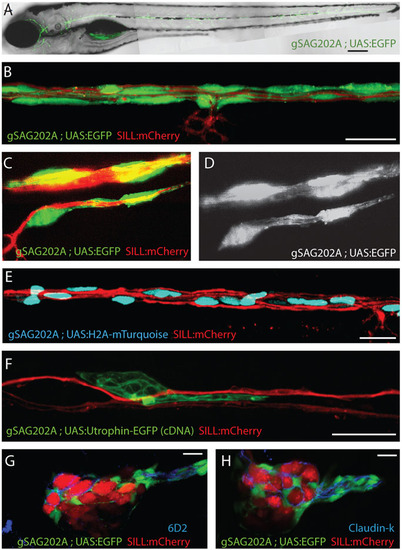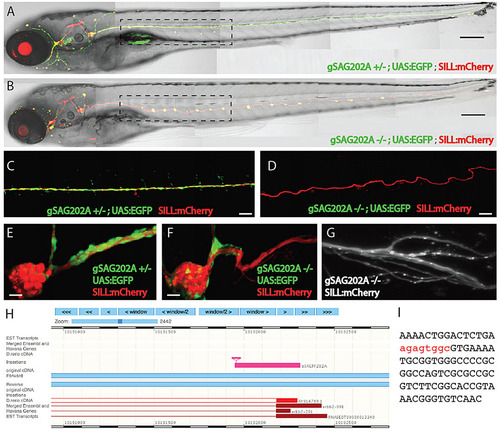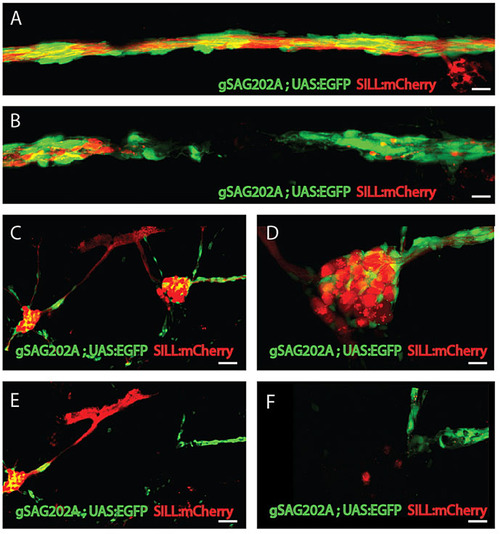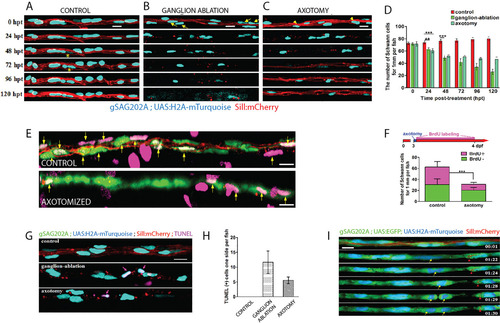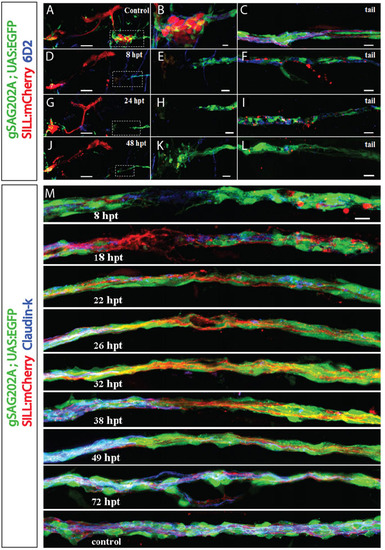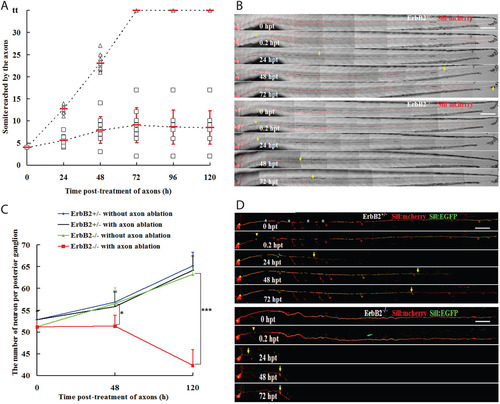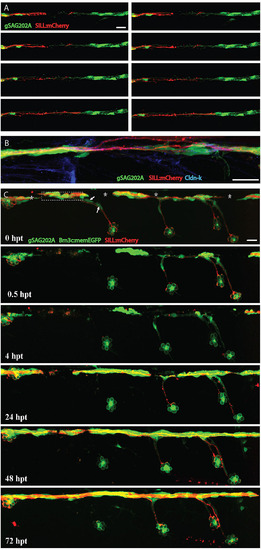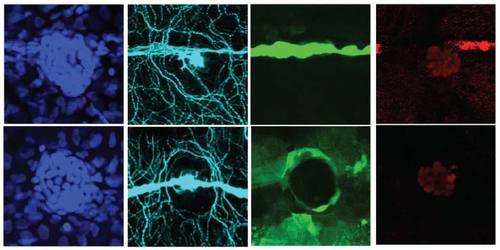- Title
-
High-resolution live imaging reveals axon-glia interactions during peripheral nerve injury and repair in zebrafish
- Authors
- Xiao, Y., Faucherre, A., Pola-Morell, L., Heddleston, J.M., Liu, T.L., Chew, T.L., Sato, F., Sehara-Fujisawa, A., Kawakami, K., López-Schier, H.
- Source
- Full text @ Dis. Model. Mech.
|
Tg[gSAGFF202A] is a specific Gal4 driver in Schwann cells. (A) EGFP expression pattern at 5dpf by Tg[gSAGFF202A;UAS:EGFP]. (B-D) Triple transgenic Tg[gSAGFF202A;UAS:EGFP;SILL:mCherry] at 5dpf show that EGFP(+) cells form tubes wrapping around an mCherry(+) axon by confocal (B) and lattice light-sheet (C,D) imaging. (E) A triple-transgenic larva (Tg[gSAGFF202A;UAS:H2A- mTurquoise;SILL:mCherry]) at 5dpf. Nuclei of cells that are in intimate contact with lateralis afferent axons are shown in blue along the trunk. (F) Marking of individual cell shows UtrCH-EGFP expression in a 4-dpf Tg[gSAGFF202A;SILL:mCherry] double-transgenic fish injected with UAS:UtrCH-EGFP construct. (G) The marker 6D2 labels EGFP-expressing cells in a lateral plane of posterior ganglion. (H) The marker Claudin-k labels EGFP-expressing cells in a lateral plane of posterior ganglion. In all figures, dorsal is up and anterior is left. Scale bars: 150µm (A) and 10µm (B-H). EXPRESSION / LABELING:
|
|
The phenotype of homozygous Tg[gSAGFF202A] fish. (A) Heterozygous Tg[gSAGFF202A;UAS:EGFP;SILL:mCherry] 5-dpf larva treated with 4-Di-2-ASP, revealing the normal pattern of neuromasts in its posterior lateral line (five neuromasts within the dashed rectangle). (B) A homozygous Tg[gSAGFF202A;UAS:EGFP;SILL:mCherry] fish at 5dpf possesses around twice as many neuromasts (ten neuromasts within the dashed rectangle). (C,E) The normal expression pattern of the posterior ganglion and lateral line in heterozygous Tg[gSAGFF202A;UAS:EGFP;SILL:mCherry] fish at 5dpf. (D,F) At 5dpf, the abnormal expression pattern of the posterior ganglion and lateral line in homozygous Tg[gSAGFF202A;UAS:EGFP;SILL:mCherry] fish, in which Schwann cells cannot migrate far away from the posterior ganglion. (G) Lattice light-sheet imaging reveals details of the axonal defasciculation in homozygous Tg[gSAGFF202A;UAS:EGFP;SILL:mCherry] larvae at 5dpf. (H) BLAST (basic local alignment search tool) shows the insertion of Gal4FF within the ErbB2 gene. (I) The integration site indicated by red nucleotides. Scale bars: 150µm (A,B), 50µm (C,D) and 10µm (E-G). |
|
Selective axonal severing and neuronal ablation by laser>. (A,B) High magnification of the lateral line nerve (A) before laser ablation and (B) after laser ablation. The nerve and Schwann cells are precisely and completely severed with no visible damage to the surrounding tissue. (C) The maximal projections of anterior and posterior ganglion before ablation. (D) Higher magnification of posterior ganglion before ablation. (E) The image of the same animal after ablation reveals that the posterior ganglion was totally ablated. (F) Higher magnification of posterior ganglion after ablation. Scale bars: 10µm (A,B,D,F) and 50µm (C,E). EXPRESSION / LABELING:
|
|
Differential responses of Schwann cells to acute and chronic denervation. (A-C) Tg[gSAGFF202A;UAS:H2A-mTurquoise;SILL:mCherry] larvae, starting at 5dpf and following 24hpt, 48hpt, 72hpt, 96hpt and 120hpt in the control (A), ganglion-ablated (B) and axon cuts (C) groups. Yellow asterisks mark the proliferative cells. Yellow arrows and arrowheads indicate the dead cells. (D) Quantification of Schwann cells, showing a significant reduction in the group with severed axons (n=6) and the ganglion-ablated group (n=8) compared with the control group (n=5) (**P<0.001, ***P<0.0001). (E) Control and axon-transected Tg[gSAGFF202A;UAS:EGFP;SILL:mCherry] larvae treated with BrdU. (F) The larvae were subject to axon severing at 3dpf in 10mM BrdU until 24hpt followed by fresh embryo medium. Fewer BrdU-positive Schwann cells were observed in the axon-transected (n=8) compared with the control (n=8) group (***P<0.0001, two-tailed t-test). (G) Examination of apoptotic Schwann cells by TUNEL assay. Pink arrows indicate colocalization of H2A-mTurquoise with TUNEL-positive cells. (H) Quantification of TUNEL-positive Schwann cells in the control group, the ganglion-ablation group and the axon-severed group. (I) Frames captured from supplementary material Movie 2 of a Tg[gSAGFF202A;UAS:EGFP;UAS:H2A-mTurquoise;SILL:mCherry] larva with severed axons. Numbers in the lower right corners denote time elapsed from the first frame of the movie. Red arrowheads mark axon debris that has been phagocytosed by the Schwann cells. At 10hpt (01:24 time point), Schwann cells started to divide (yellow arrow) when no intact axon exists. Error bars are+or±s.d. Scale bars: 10µm (A-C,E,G,I). |
|
Gradual loss of expression of myelin glycoprotein and Claudin-k junctional protein upon axon severing or ganglion ablation. (A-L) Maximal projection of Tg[gSAGFF202A;UAS:EGFP;SILL:mCherry] larvae immunolabeled with myelin 6D2 antibody (blue). (A,D,G,J) The cephalic region showing the anterior and posterior ganglion before ganglionostomy (A) and at 8-48hpt in fish with ganglion ablation (D,G,J). (B,E,H,K) Higher magnification of the boxed regions in A,D,G,J, respectively. (C,F,I,L) Images of the animals? tail, corresponding to A,D,G,J. (D,G,J) At 8hpt, 24hpt, 48hpt, immunostaining images reveals gradual loss of myelin protein. (F,I,L) Immunostaining of fish tails delineates the loss of myelin and clearance of axon debris in a gradual manner. (M) Time-course analysis of axonal regeneration and Claudin-k junctional protein expression (blue) in the Schwann cells around the site of damage. Claudin-k is present along the perineurium in control fish (lowest panel). A marked reduction of Claudin-k in the perineurium distal to the cutting site can be seen at 8hpt. Distal Claudin-k protein levels remain lower than on the proximal part of the perineurium even after axonal regeneration at 26hpt, and only level-up around 72hpt. Scale bars: 50µm (A,D,G,J), 10µm (all others). EXPRESSION / LABELING:
|
|
Schwann cells facilitate but are dispensable for axonal regeneration. (A) The axons were severed at somite 3 in 5-dpf larvae. The somite reached by the regenerating nerve was examined at 24, 48, 72, 96 and 120hpt. In all cases (n=10), the axons had reached the tip of the body and re-innervated the terminal neuromasts at 72hpt in Tg[gSAGFF202A+/SILL:mCherry] (triangles). All cases (n=10) of Tg[gSAGFF202A/SILL:mCherry] fish revealed an abnormal and lower regeneration rate (squares). (B) Examples of axon regeneration after injury in heterozygous and homozygous Tg[gSAGFF202A;SILL:mCherry]. (C) Sum of neuron numbers in posterior ganglion at 5dpf, 48hpt and 120hpt in Tg[gSAGFF202A+/SILL:mCherry] and Tg[gSAGFF202A/SILL:mCherry] larvae upon laser-mediated axon severing or in the untreated group. n=6 fish per group (*P<0.05, ***P<0.0001). (D) Examples of an identified axon?s regeneration after damage in heterozygous and homozygous Tg[gSAGFF202A;SILL:mCherry] fish injected with SILL:EGFP. Yellow arrowheads and arrows point to cutting sites and to the tip of regenerate axons, respectively. White asterisks mark pigment cells. Error bars are+or±s.d. Scale bars: 150µm (B,D). |
|
Regenerating axons followed Schwann cell processes. (A) Frames captured from time-lapse supplementary material Movie 4 of a Tg[gSAGFF202A;UAS:EGFP;SILL:mCherry] larva with severed axons, leaving a glial gap. Time elapsed from the first frame of the movie are, from left to right and top to bottom: 00:04, 00:20, 00:30, 00:40, 00:45, 00:46, 00:49, 00:52. Pictures were taken every 8min, starting 4h after axon severing. At 16hpt (00:45 time point), axons started to regrow when Schwann cells filled the gap. (B) An example of partially defasciculated axons at the site of injury. (C) A quadruple transgenic Tg[gSAGFF202A;UAS:EGFP;SILL:mCherry;Brn3c:mEGFP] larva starting at 6dpf and following 0.5hpt, 4hpt, 24hpt, 48hpt and 72hpt after axon severing and ablation of lateral Schwann cells. At 24hpt, regenerating axons re-innervated the neuromast with lateral Schwann cells, but failed to re-innervate neuromasts devoid of lateral Schwann cells even at 72hpt. Asterisks mark pigment cells. Arrows point to ablated lateral Schwann cells. Dash frame indicates the site of the cut. Scale bars: 25µm. |
|
This series of images further show that Schwann cells are absent in along the trunk of the fish with a homozygous Tg[gSAGFF-202A] insertion. While EGFP (green) in Tg[gSAGFF-202A;UAS:EGFP] heterozygous fish at 96 hpf is expressed in Schwann cells surrounding the lateral-line afferent axons labeled with and antibody to acetylated tubulin (turquoise), the EGFP signal is absent from the perineurium, and appears upregulated in neuromasts in Tg[gSAGFF- 202A;UAS:EGFP] homozygous fish. The lateral line contains hair cells, which were labeled with an antibody to S100 (red). Cellular nuclei were labeled with DAPI (blue). |

